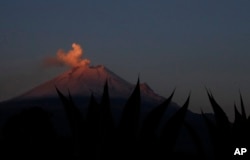The people of Santiago Xalitzintla wake up well before sunrise to prepare their offerings to The Sleeping Woman. That is what the villagers call the Iztaccíhuatl volcano, just a short drive from their town in central Mexico.
Iztaccíhuatl is no longer active. The name Sleeping Women comes from the fact that the silhouette of the volcano looks like that of a woman lying down.
The local people have a large ceremonial meal at the end of the day. They also bring plenty of red flowers. They leave them at a stone altar on the side of the mountain.
Hundreds of people take the three-hour walk to the mountain top twice a year to ask for the volcano’s aid and protection. To get there, they must walk along small rivers and pass through a pine forest.
The villagers call on the Sleeping Woman to bring rain for their crops and to protect their harvests from bad weather. They also ask her to calm the ashy eruptions of her neighbor, the active Popocatepetl volcano.
Keeping a watch on Don Goyo
Veronica Agustin says the community has gotten used to living with Don Goyo, a nickname for Popocatepetl. When Don Goyo gets angry, the ground moves and doors and windows shake.
Santiago Xalitzintla is the closest community to Popocatepetl. The volcano has been releasing lava and dust particles that sometimes even reach Mexico City, 90 kilometers to the northwest.
Mexican officials have told the villagers to be prepared for the worst. The town has a warning system to tell locals when they should escape to the nearby city of Cholula.
The trip to the altar is a tradition that goes back generations. The people of Santiago Xalitzintla celebrate over two days in early May, shooting fireworks into the sky above their town. They drink large amounts of tequila and cook communal meals over open fires.
They lay the offerings out on an altar on the side of the mountain There is fruit cut into flower shapes. Villagers also leave cups of milky pulque — an alcoholic drink made from the juice of the maguey plant.
It is the Day of the Holy Cross, a religious holiday celebrated in many parts of Central and South America. It marks Byzantine Empress Saint Helena’s search for the cross on which Jesus was executed.
A mix of Christianity and local customs
The ceremony mixes Catholic traditions with pre-Hispanic customs and beliefs.
The villagers hold a Roman Catholic religious service and sing Catholic songs. They ask the Virgin Mary, the mother of Jesus Christ, to forgive them for the mistakes they have made.
A conch shell is blown. Drums are played. And a song begins in the native Nahuatl language to honor the Aztec mother earth goddess. People here often celebrate her alongside the Virgin Mary.
Larion Hernandez joined the march from another village below the volcanoes. Hernandez explains first in Nahuatl and then in Spanish why he feels the offerings to Iztaccíhuatl are so important.
“We came to leave an offering and also to ask her, our mother of this place, to give us good harvests and also to thank her at the same time for past harvests,” he said.
The harvest in this part of Puebla State is mainly corn, the base of the Mexican diet.
“As mother earth, we should take care of her because she gives us food to eat, and we should take care of her,” Hernandez said.
I’m Caty Weaver.
Marcelo Viano and Amy Guthrie reported this story for the Associated Press. George Grow adapted the story for Learning English. Ashley Thompson was the editor.
We want to hear from you. Write to us in the Comments section, and visit our Facebook page.
_____________________________________________________________
Words in This Story
silhouette – n. a likeness of a body or some other object
altar – n. a usually raised structure on which sacrifices are offered; a table-like structure used in Christian religious services
eruption – n. the act of something exploding
lava – n. the liquid rock released by a volcano
cross – n. an object built or shaped like the letter “T”












